 I guess this should go without saying (!) . . . .But sometimes humans really need to be reminded about the importance of being VERY cautious in areas where American Alligators are present.
I guess this should go without saying (!) . . . .But sometimes humans really need to be reminded about the importance of being VERY cautious in areas where American Alligators are present. American Alligators are truly a relic from the past (National Geographic). These prehistoric-looking creatures, who are common in the wetlands of the southern U.S., were once on the Endangered Species List, but since 1987, are considered recovered. (U.S. Fish & Wildlife)
American Alligators are truly a relic from the past (National Geographic). These prehistoric-looking creatures, who are common in the wetlands of the southern U.S., were once on the Endangered Species List, but since 1987, are considered recovered. (U.S. Fish & Wildlife) The preserves, parks, refuges and sanctuaries we have frequented usually provide excellent signage, reminding visitors not to disturb the wildlife, including the Alligators, who live there.
The preserves, parks, refuges and sanctuaries we have frequented usually provide excellent signage, reminding visitors not to disturb the wildlife, including the Alligators, who live there. It is genuinely a highly serious matter to respect Alligators – and to take every precaution – when one enters into their territory. When sunning themselves or gliding slowly by in the water, gators may appear deceptively docile, but can be extremely dangerous if approached, especially near their nest.
It is genuinely a highly serious matter to respect Alligators – and to take every precaution – when one enters into their territory. When sunning themselves or gliding slowly by in the water, gators may appear deceptively docile, but can be extremely dangerous if approached, especially near their nest. 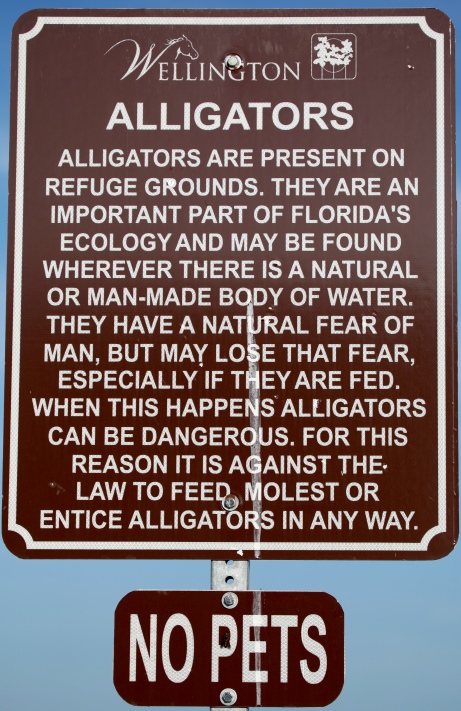
 Often, only their snouts appear above the surface of the water, but sometimes, gators appear to be trying to camouflage themselves when in full view, like this fellow snoozing in his ‘camo jacket’ in the sand above.
Often, only their snouts appear above the surface of the water, but sometimes, gators appear to be trying to camouflage themselves when in full view, like this fellow snoozing in his ‘camo jacket’ in the sand above.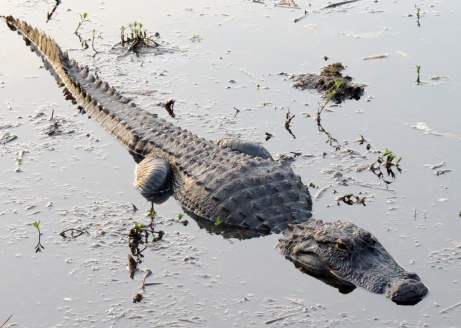 Female American Alligators generally grow to be about 10 feet long, while male adults can be 12-14+ feet in length (Florida Fish & Wildlife).
Female American Alligators generally grow to be about 10 feet long, while male adults can be 12-14+ feet in length (Florida Fish & Wildlife). Right now – late August to September – is the time that baby gators hatch, following an incubation period of about two-months. If you look closely at the iPhone shot above, you can glimpse a female near her nest by the water’s edge.
Right now – late August to September – is the time that baby gators hatch, following an incubation period of about two-months. If you look closely at the iPhone shot above, you can glimpse a female near her nest by the water’s edge.
She listens for the hatchlings’ calls, and when they are ready to emerge, the mother assists by clearing away the brush she used to hide her nest, and carrying the babies gently in her mouth to the water (Crocodilian.com).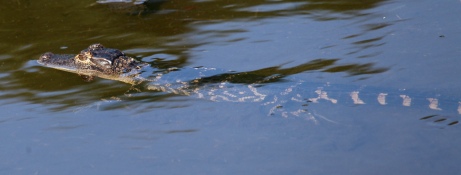 When you spot baby or juvenile yellow-striped Alligators, the mother is nearly always VERY close by.
When you spot baby or juvenile yellow-striped Alligators, the mother is nearly always VERY close by. 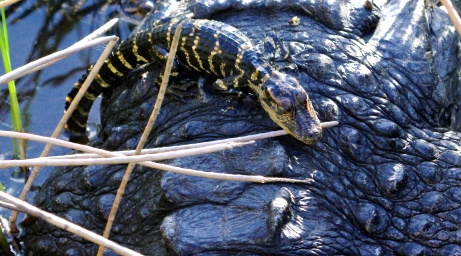 American Alligator mothers care for the young, who grow about 1 foot in length per year, for a year or more (National Park Service). From a typical litter of 35+ hatchlings, usually only 5 survive till full adulthood.
American Alligator mothers care for the young, who grow about 1 foot in length per year, for a year or more (National Park Service). From a typical litter of 35+ hatchlings, usually only 5 survive till full adulthood.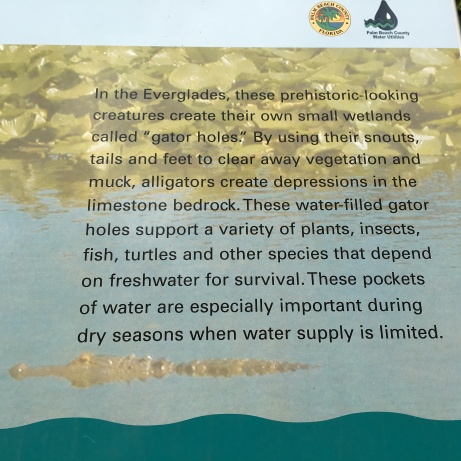 As described in the sign above, ‘Alligator Holes‘, like the one below, are often found where Alligators are common.
As described in the sign above, ‘Alligator Holes‘, like the one below, are often found where Alligators are common. 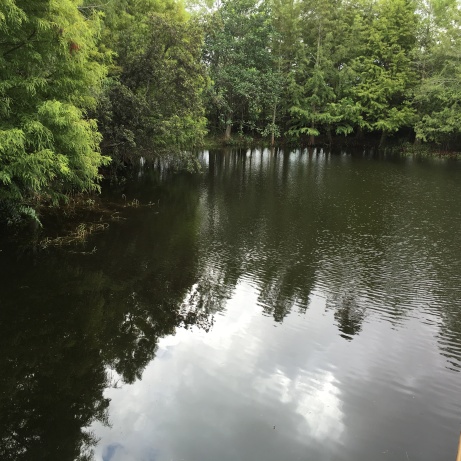 This large Alligator Hole also provides a wonderful habitat for many types of wetland birds, as well as fish and other aquatic animals.
This large Alligator Hole also provides a wonderful habitat for many types of wetland birds, as well as fish and other aquatic animals.
“The story of the American alligator is one of both drastic decline and complete recovery. A story of State and Federal cooperation, it is truly one of the prominent successes of the Nation’s endangered species program.” (U.S. Fish & Wildlife)


So informative!! They are truly intriguing…
LikeLiked by 1 person
Thanks, Yaffa! There is so much to learn about these amazing creatures.
LikeLike
A great quickie education on a bizarre, ancient, and mysterious species. As many as we see here in Florida they remain captivating and “demand ” in silence, our attention.🐊🐊🐊
LikeLiked by 1 person
They certainly are ancient and mysterious, Berny. Thanks for your visit and your comments~!
LikeLike
I don’t think people who visit states that have alligators do not take the sign seriously…curiosity killed the cat. There’s a dog beach near us in Florida that has a walkway (ground level) from parking lot to beach and a sign beware of alligators. Although, I never seen one there, it scares me to death. 😁
LikeLiked by 1 person
I know what you mean! It can be intimidating to see such signs posted when we’re out in more remote areas. I feel far more secure up on nice safe wetland boardwalks.
It’s nice to see you posting again – hope you’re doing well Connie!
LikeLiked by 1 person
Doing better. I drove for the first time yesterday, and went to a small mall to walk, but the store doors are too heavy to open, so I ask people that are near by if they could please open them for me.
LikeLiked by 1 person
Good to hear ;-D
LikeLiked by 1 person
😀
LikeLike
This is outstanding. My favorite Floridian reptile!!!! Stop getting so close to those things!
LikeLiked by 1 person
Thanks, Oren! Have you seen any gators yourself lately on recent trips to Florida🐊!?
LikeLike
What a great and informative post, BJ! I have lots of respect for gators since my years in Africa, where crocs were present in most rivers.
LikeLiked by 1 person
Thanks, Tiny. Yipes, I can’t even imagine being in close proximity to crocodiles in Africa. That must have been an amazing experience.
LikeLiked by 1 person
Great post and info! I can’t help but say the little fella on momma really is kind of cute. 🙂
LikeLiked by 1 person
They are pretty cute! There are new baby gators recently hatched in two nearby locations that I haven’t even have a chance to see yet.
LikeLiked by 1 person
Wonderful place! I like your pictures a lot, very nice blog, thanks for sharing! I will write soon an article on Everglades alligators, keep in touch, following your blog!
LikeLiked by 1 person
Thanks so much for your very kind comments, and for following my blog. I look forward to seeing your posts about the Everglades
LikeLiked by 1 person